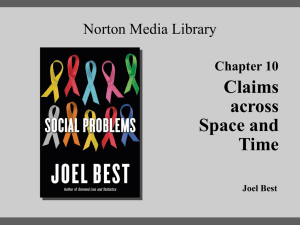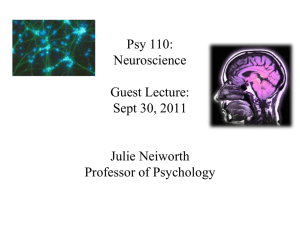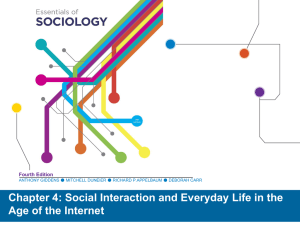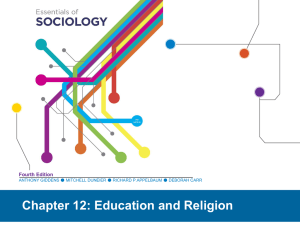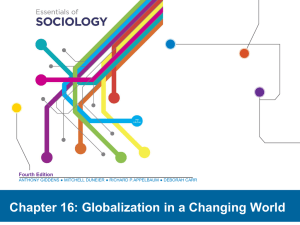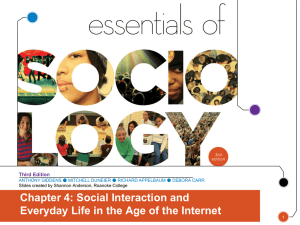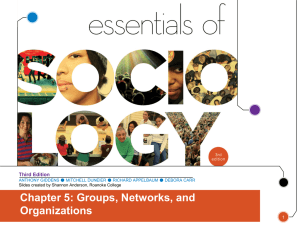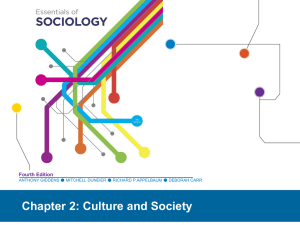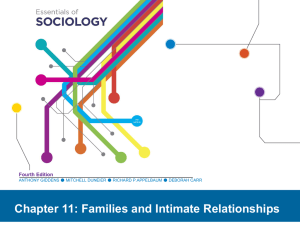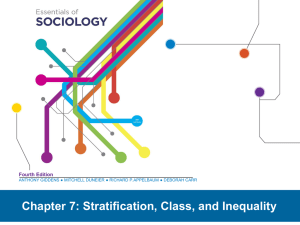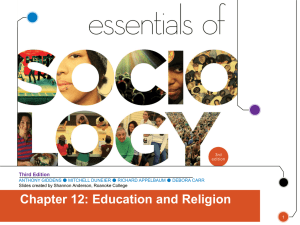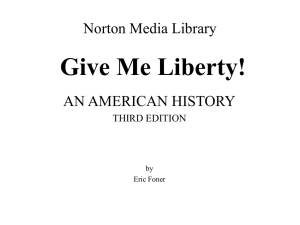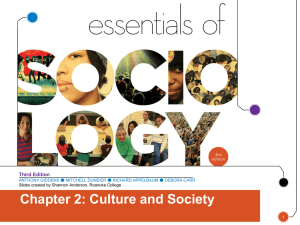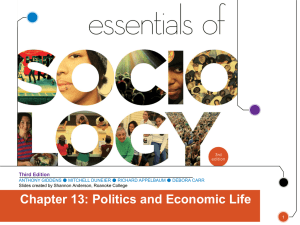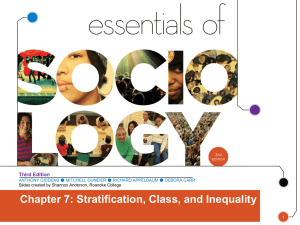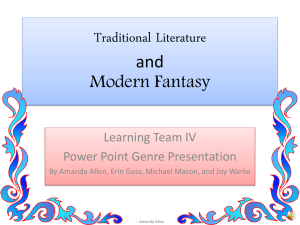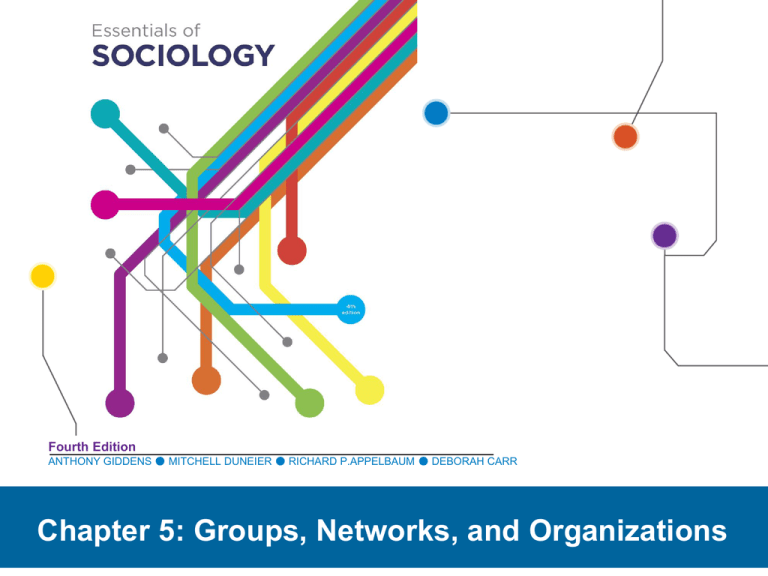
Fourth Edition
ANTHONY GIDDENS ● MITCHELL DUNEIER ● RICHARD P.APPELBAUM ● DEBORAH CARR
Chapter 5: Groups, Networks, and Organizations
The outcome of teamwork
© 2013 W. W. Norton Co., Inc.
2
Why group-life matters
• Life in social groups of various shapes and
sizes is a fundamentally sociological topic.
• Human life is lived largely in group
contexts.
• Human behavior cannot be properly
analyzed in purely individual terms.
© 2013 W. W. Norton Co., Inc.
3
Unit cohesion
•
Example of West Point:
–
–
Giving up of self in favor of the group
Bonds of discipline, loyalty, and conformity
–
Strong sense of “unit cohesion”
© 2013 W. W. Norton Co., Inc.
4
Social groups
• Social groups are:
– People who interact with each other and share a
sense of identity
– People who have a shared set of social
expectations and values (a set of social norms)
• Typically, there is some awareness of social
boundaries.
© 2013 W. W. Norton Co., Inc.
5
Types of groups
• In-groups and out-groups: “us” and “them”
• Primary and secondary groups
– Primary: the closest, most basic, intimate
forms of association
– Secondary: large, impersonal, impermanent
forms of association
• Reference groups: provide social standards
© 2013 W. W. Norton Co., Inc.
6
Group size
• Sociologists interested in group size look at
varying qualities of interaction based on size.
• Georg Simmel: dyads, triads, and larger
groups
• As group size increases . . .
– Intensity decreases
– Formal organization increases
– Stability and exclusivity increase
© 2013 W. W. Norton Co., Inc.
7
Dyads, Triads, and More
© 2013 W. W. Norton Co., Inc.
8
Dyads
The larger the number of people,
the greater the possible number
of relationships.
Note that this figure illustrates only dyads;
if triads and more complex coalitions were
to be included, the numbers would still be
greater (four people yield ten possibilities).
Bob
Mary
2 PEOPLE = 1 RELATIONSHIPS
Bob
Bob
Mary
3 PEOPLE = 3 RELATIONSHIPS
Juanita
Juanita
Juanita
Bob
Juanita
Bob
Mary
Wendy
Carlos
Mary
Mary
Wendy
4 PEOPLE = 6 RELATIONSHIPS
© 2013 W. W. Norton Co., Inc.
Wendy
Carlos
5 PEOPLE = 10 RELATIONSHIPS
Li
6 PEOPLE = 15 RELATIONSHIPS
Leadership
• All groups have leaders.
• There are transformational leaders and
transactional leaders.
• Transformational leaders are inspirational
and change the purpose and meaning of the
group.
• Transactional leaders are pragmatic and
interested in accomplishing tasks.
© 2013 W. W. Norton Co., Inc.
10
Conformity: The research
• People largely conform to group norms.
• Three important studies to know:
– Solomon Asch: Group pressure
– Stanley Milgram: Obedience to authority
– Irving L. Janis: Groupthink
© 2013 W. W. Norton Co., Inc.
11
Social networks
• Social networks are composed of direct and
indirect associations that link people and
groups.
• Networks offer connections beyond the
immediate, and thereby can extend
opportunities.
© 2013 W. W. Norton Co., Inc.
12
Networks and inequality
• Different groups have access to more or less
helpful networks. This exacerbates
inequalities that are already in place.
© 2013 W. W. Norton Co., Inc.
13
Online social networking
• Online social networking offers many of
the same benefits as conventional
networks, without some of the constraints.
• The Internet was originally used for
military and academic purposes, but now it
is available (and used) as a network for
hundreds of millions of users—an
estimated 245 million Americans in 2011.
© 2013 W. W. Norton Co., Inc.
14
Unequal access online
• Though the digital divide seems to be closing
in terms of basic access to the Internet,
disparities remain.
• Those with family incomes under $75,000/yr
use the Internet less than those with higher
incomes, and the differences in usage expand
when looking at those earning less than
$30,000/yr.
© 2013 W. W. Norton Co., Inc.
15
Organizations
• Organizations are groups that associate for
the purpose of achieving some goal or action.
• Organizations have identifiable membership.
• The study of organizations is a core topic in
sociology, as they are one of the dominant
forms of social relations.
© 2013 W. W. Norton Co., Inc.
16
Formal organizations
• Many organizations take on a highly rational
form, with a clear chain of command and
standard operating procedures (SOPs).
• Formality is often for the purposes of legality
and legitimacy.
• Formal organizations have become
increasingly important in modernity.
© 2013 W. W. Norton Co., Inc.
17
Organizational theory
• There are many approaches to studying
organizations sociologically:
–
–
–
–
–
Bureaucracy theories
Informal networks
Dysfunction theory
Oligarchy
Feminist organizational theory
© 2013 W. W. Norton Co., Inc.
18
Bureaucracy
• A bureaucracy is a formal organization best
known for its style of hierarchical authority.
– Pros: effectiveness, careful operations
– Cons: dehumanizing, red tape
• Max Weber is the sociologist most closely
associated with bureaucracy theory.
© 2013 W. W. Norton Co., Inc.
19
Weber on bureaucracy
• Weber saw bureaucracies as the future of
organizations in the modern world.
• They were highly efficient compared to
earlier, less rational forms of organization
(see his ideal type).
• Weber recognized the plusses and minuses.
He saw bureaucracy as inevitable due to its
effectiveness but worried over its dullness
and lack of humanity.
© 2013 W. W. Norton Co., Inc.
20
Informal relations
• An early challenge to bureaucracy theory came
from those who identified informal networks
and relations inside formal organizations.
– Informal relations and chains of command
function within organizations.
• Fruitful, informal social-business networks
also exist between organizations.
© 2013 W. W. Norton Co., Inc.
21
Harmful effects of bureaucracy
• Robert Merton identified what he saw as the
dysfunctions of bureaucracy.
– Bureaucracy stifles creativity with its sea of
rules and SOPs.
– Bureaucracy is also overly pragmatic and
lacks a visionary element.
– Occasionally, rules dominate goals.
© 2013 W. W. Norton Co., Inc.
22
Other organizational theories
• The iron law of oligarchy: the rule of the
few over the many
• Feminist approaches to organizational
studies
– Organizations are structured in a gendered way,
which reinforces gender inequality in society.
– Gender inequality in organizations persists.
© 2013 W. W. Norton Co., Inc.
23
Figure 5.3 Balancing Act?
© 2013 W. W. Norton Co., Inc.
Does bureaucracy theory hold up?
• There have been both theoretical and applied
challenges to bureaucracy as the only model of
formal organization in the modern world.
– Horizontal models of formal organization
– Decentralization of organizations (e.g.,
telecommuting)
– McDonaldization
© 2013 W. W. Norton Co., Inc.
25
Social capital
• Social capital is what we gain in knowledge,
networks, and status through participation and
membership in groups and organizations.
• Social capital contributes to feelings of wellbeing and belonging, in addition to economic
success.
• There is a great deal of inequality in social
capital among individuals, organizations, and
even countries.
© 2013 W. W. Norton Co., Inc.
26
This concludes the Lecture
PowerPoint Presentation for
Chapter 5: Groups, Networks, and Organizations
For more learning resources, please visit our online StudySpace at:
http://www.wwnorton.com/college/soc/essentials-of-sociology7/
W. W. Norton & Company
Independent and Employee-Owned
© 2013 W. W. Norton Co., Inc.
Clicker Questions
1. The term for the social knowledge and connections that enable
people to accomplish their goals and extend their influence is
a. cultural capital.
b. political capital.
c. social capital.
d. economic capital.
© 2013 W. W. Norton Co., Inc.
28
Clicker Questions
2. What is an example of how gender is embedded in the very
structure of modern organizations?
a. The benefits that female workers receive are different from
those of male workers.
b. Facilities within modern organizations (bathrooms and break
rooms) are segregated by sex.
c. The ideas of a bureaucratic career are based on the male career,
with women cast in supporting roles.
d. It is acceptable for women to take more frequent bathroom
breaks than men.
© 2013 W. W. Norton Co., Inc.
29
Clicker Questions
3. Which kind of group provides standards by which we judge
ourselves?
a. an in-group
b. a primary group
c. an out-group
d. a reference group
© 2013 W. W. Norton Co., Inc.
30
Clicker Questions
4. Which of the following would be the best example of a formal
organization?
a. all of the people of the United States who self-identify as
“working class”
b. the group of people gathered at the corner of First Avenue and
Elm, waiting for the 2:36 p.m. #4 bus
c. the Church of Jesus Christ of Latter-Day Saints (the
“Mormons”)
d. the collection of siblings and older cousins that provides one
with a standard for judging one’s own attitudes or behavior
© 2013 W. W. Norton Co., Inc.
31
Clicker Questions
5. Which of the following is one of Weber’s characteristics of
bureaucracy?
a. There is a clear-cut hierarchy of authority.
b. Officials are part time and paid by the hour.
c. Members of the organization own the material resources with
which they operate.
d. There is no clear-cut separation between the tasks of an official
within the organization and his life outside.
© 2013 W. W. Norton Co., Inc.
32
Clicker Questions
6. Which of the following is a characteristic of a primary group?
a. Members interact face-to-face.
b. It is impersonal.
c. Members interact to achieve a specific goal.
d. There is a weak sense of bonding and commitment.
© 2013 W. W. Norton Co., Inc.
33
Clicker Questions
7. What is the “iron law of oligarchy”?
a. Weber’s theory of red tape
b. Michels’s theory that there is an inherent tendency for power
to concentrate at the top of large organizations
c. Weber’s theory that power concentrates in the hands of
permanent officials at the expense of an organization’s elected
officials or appointed directors
d. the feminist theory that power always concentrates in the hands
of men
© 2013 W. W. Norton Co., Inc.
34

